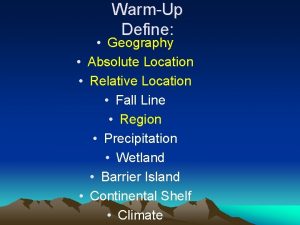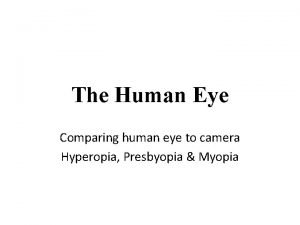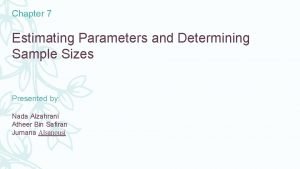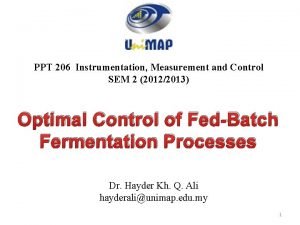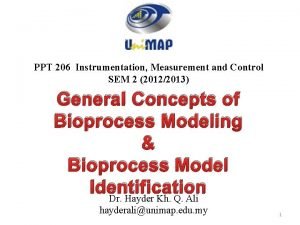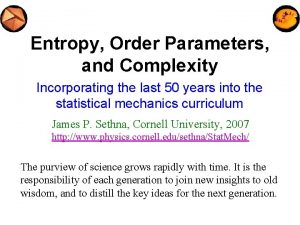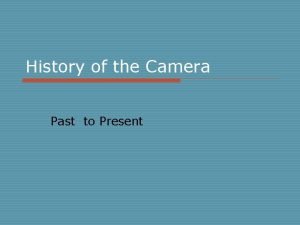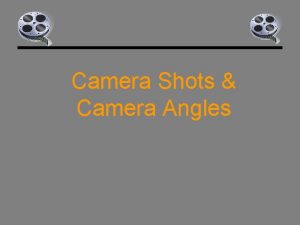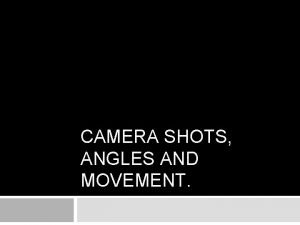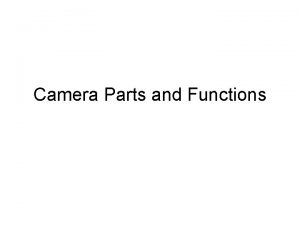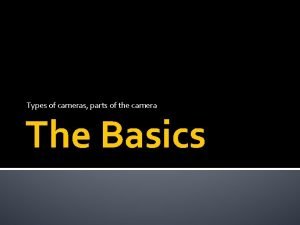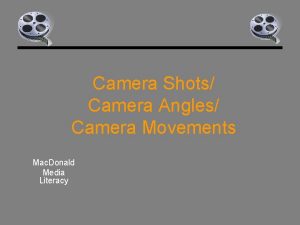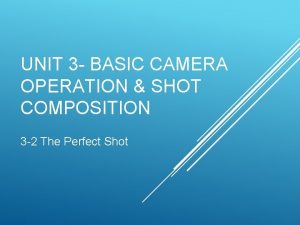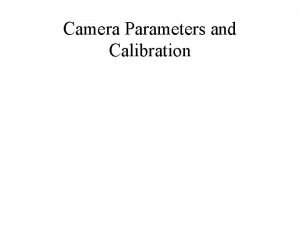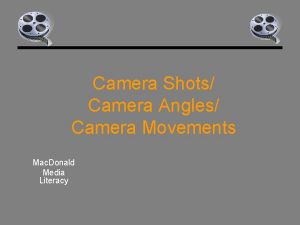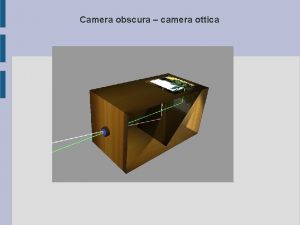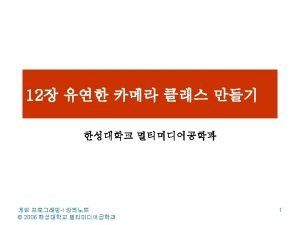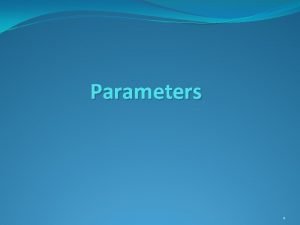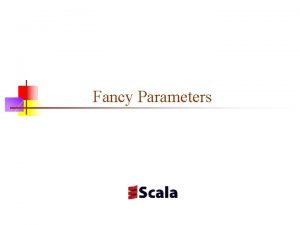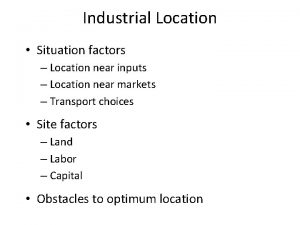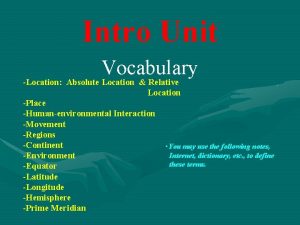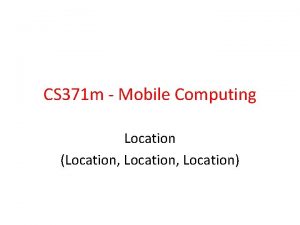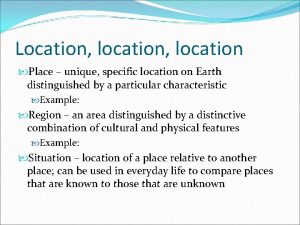Camera parameters Extrinisic parameters define location and orientation































- Slides: 31

Camera parameters

• Extrinisic parameters define location and orientation of camera reference frame with respect to world frame • Intrinsic parameters define pixel coordinates of image point with respect to coordinates in camera reference frame

Homogenous coordinates Add an extra coordinate and define equivalence Relationship (x, y) -> (kx, ky, k) (X, Y, Z) -> (w. X, w. Y, w. Z, w) Makes it possible to write the Perspective projection as a linear Transformation (matrix) (from projective space to projective plane)

Central projection HC NHC

Scaled orthographic projection HC NHC





In a simpler notation T describes the position of the origin of camera frame with respect to world frame R describes the rotation which aligns the camera frame with the world frame Pc = R(Pw – T) (here –RT = BOA)

Translation and Rotation

Intrinsic parameters y x ypix xpix Scaling

Intrinsic parameters y x ypix xpix

Intrinsic parameters y x ypix xpix

The internal calibration parameters

with

Properties of matrix M • M has 11 degrees of freedom (5 internal 3 rotation, 3 translation parameters) , 3 x 4 matrix defined up to scale • The 3 x 3 submatrix M’=Mint. R is nonsingular (Mint is upper triangular, R is orthogonal -> essential QR decomposition)

Radial distortion from lens distortion (pin cushioning effect) (significant error for cheap optics and short focal length) Straight lines are not imaged straight x and xd measured from image center

Radial calibration Using lines to be straight (x’, y’) is radial projection of (xd, yd) on straight line


Calibration Procedure • Calibration target : 2 planes at right angle with checkerboard (Tsai grid) • We know positions of corners of grid with respect to a coordinate system of the target • Obtain from images the corners • Using the equations (relating pixel coordinates to world coordinates) we obtain the camera parameters (the internal parameters and the external (pose) as a side effect)

Image Processing • • Canny edge detection Straight line fitting to detect long edges Intersection of lines to detect image corners Matching image corners and 3 D checkerboard corners

Estimation procedure • First estimate M from corresponding image points and scene points (solving homogeneous equation) • Second decompose M into internal and external parameters • Use estimated parameters as starting point to solve calibration parameters non-linearly.

(homogeneous equation)


Solving A m = 0 Linear homogeneous system Have at least 5 times as many equations as unknowns (28 points) Minimize ||Am||2 with the constraint ||m||2=1 M is the unit singular value of A corresponding to the smallest singular value (the last column of V, where A = UDVT is the SVD of A), or the eigenvector (corresponding to smallest eigenvalue ) of ATA

Finding camera translation (position of camera center) Let be the homogeneous representation of T is the null vector of M: Null vector is found using SVD ( is the unit singular vector corresponding to the smallest singular value of M)

Finding camera orientation and internal parameters • Left 3 x 3 submatrix of M is of the form M’= Mint R Mint upper triangular R orthogonal • Any nonsingular matrix can be decomposed into the product of an upper triangular and an orthogonal matrix (RQ factorization—here R refers to upper triangular and Q to orthogonal) (Similar to QR factorization)

RQ factorization of M’ • Givens rotations To set M’ 32 to zero, solve equation Thus: Multiply M’ by Rx ( such that term (3, 2) is 0), then by, Ry (choosing c’, s’ such that term (3, 1) is zero), then by Rz (with c’’, s’’ such that term (2, 1) is zero)

Improving solution with nonlinear optimization Find m using the linear constraint Use as initialization for nonlinear optimization (Levenberg-Marquardt iterative minimization)

Algorithm described in Multiple View Geometry in Computer Vision (Hartley, Zisserman)
 Ethnocentric orientation and polycentric orientation ignou
Ethnocentric orientation and polycentric orientation ignou Single camera production
Single camera production Single camera vs multi camera
Single camera vs multi camera A cross country skier moves from location a to location b
A cross country skier moves from location a to location b Location planning and analysis in operation management
Location planning and analysis in operation management Social and environmental responsibility grade 12
Social and environmental responsibility grade 12 Democracy and human rights grade 12 life orientation
Democracy and human rights grade 12 life orientation Define orientation program
Define orientation program Define fall line
Define fall line Eye camera comparison
Eye camera comparison Lesson 4 parameters and return make rock paper scissors
Lesson 4 parameters and return make rock paper scissors Parameters and return practice
Parameters and return practice Estimating parameters and determining sample sizes
Estimating parameters and determining sample sizes Lesson 3 parameters and return practice 7
Lesson 3 parameters and return practice 7 Intrinsic parameters of food
Intrinsic parameters of food Computer control of fermentation process ppt
Computer control of fermentation process ppt Hydraulic structures ppt
Hydraulic structures ppt Entropy order parameters and complexity
Entropy order parameters and complexity Bias through statistics and crowd counts
Bias through statistics and crowd counts Bias by photos captions and camera angles examples
Bias by photos captions and camera angles examples History of the camcorder
History of the camcorder Camera shots and angles quiz
Camera shots and angles quiz Camera shots angles and movements
Camera shots angles and movements Camera shots and angles
Camera shots and angles Camera parts and functions
Camera parts and functions Pinhole camera advantages and disadvantages
Pinhole camera advantages and disadvantages Camera parts and functions
Camera parts and functions Advantages and disadvantages of digital camera
Advantages and disadvantages of digital camera Wide field and planetary camera 2
Wide field and planetary camera 2 Chapter 2 camera handling care and support
Chapter 2 camera handling care and support Mac extreme pan to
Mac extreme pan to Camera operation and picture composition
Camera operation and picture composition








